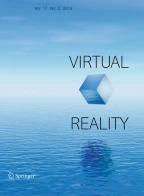Abstract
Tactile transmission systems deliver tactile information such as texture roughness to operators of robotic systems. Such systems are typically composed of tactile sensors that sense the physical characteristics of textures and tactile displays that present tactile stimuli to operators. One problem associated with tactile transmission systems is that when the system has a bottleneck, it is difficult to identify whether the tactile sensor, tactile display, or perceptual ability of the user is the cause because they have different performance criteria. To solve this problem, this study established an evaluation method that uses the discriminability index as an evaluation criterion. The method lets tactile sensors, displays, and human tactile perception be assessed in terms of the ability to transmit physical quantities; the same criterion is used for all three possible causes so that their abilities can be directly compared. The developed method was applied to a tactile-roughness transmission system (Okamoto et al. 2009), and its tactile sensor was identified as the bottleneck of the system.








Similar content being viewed by others
Explore related subjects
Discover the latest articles, news and stories from top researchers in related subjects.References
Dev P, Harris D, Gutierrez D, Shah A, Senger S (2002) End-to-end performance measurement of internet based medical applications. In: Proceedings the 2002 American Medical Informatics Association annual symposium, pp 205–209
Fan FE, Culjat MO, King C, Franco ML, Boryk R, Bisley JW, Dutson E, Grundfest WS (2008) A haptic feedback system for lower-limb prostheses. IEEE Trans Neural Syst Rehabil Eng 16(3):270–277
Goethals P, Lintermans H, Sette MM, Reynaerts D, Brussel HV (2008) Powerful compact tactile display with microhydraulic actuators. In: Proceedings of the EuroHaptics 2008, pp 447–457
Goff GD (1967) Differential discrimination of frequency of cutaneous mechanical vibration. J Exp Psychol 74(2):294–299
Green DM, Swets JA (1966) Signal Detection theory and psychophysics. Wiley, New York
Gulliksen H (1956) A least squares solution for paired comparisons with incomplete data. Pcyhometrika 21(2):125–134
Hikichi K, Yasuda Y, Fukuda A, Sezaki K (2006) The effect of network delay on remote calligraphic teaching with haptic interfaces. In: Proceedings of the 5th workshop on network & system support for games, no 12
Howe RD, Peine WJ, Kontarinis DA, Son JS (1995) Remote palpation technology. IEEE Eng Med Biol 14(3):318–323
International Telecommunication Union (2004) Subjective assessment of sound quality. ITU-R Recommendation BS.562-3
International Telecommunication Union (2009) Methodology for the subjective assessment of the quality of television pictures. ITU-R Recommendation BT.500-12
Jones LA, Lederman SJ (2006) Human hand function. Oxford University Press, Oxford
Killebrew JH, Bensmaa SJ, Dammann JF, Denchev P, Hsiao SS, Craig JC, Johnson KO (2007) A dense array stimulator to generate arbitrary spatio-temporal tactile stimuli. J Neurosci Methods 161(1):62–74
Kontarinis DA, Howe RD (1995) Tactile display of vibratory information in teleoperation and virtual environments. Presence 4(4):387–402
Macmillan NA, Creelman CD (2005) Detection theory—a user’s guide. Lawrence Erlbaum Associates, Hillsdale
Motoo K, Arai F, Fukuda T (2007) Piezoelectric vibration-type tactile sensor using elasticity and viscosity change of structure. IEEE Sensors J 7(7):1044–1051
Mukaibo Y, Shirado H, Konyo M, Maeno T (2005) Development of a texture sensor emulating the tissue structure and perceptual mechanism of human fingers. In: Proceedings of the 2005 IEEE international conference on robotics and automation, pp 2565–2570
Okamoto S, Konyo M, Maeno T, Tadokoro S (2009) Transmission of tactile roughness through master-slave systems. In: Proceedings of the 2009 IEEE international conference on robotics and automation, pp 1467–1472
Ottermo MV (2006) Virtual palpation gripper. Dissertation, Norwegian University of Science & Technology
Pawluk DTV, Son JS, Wellman PS, Peine WJ, Howe RD (1998) A distributed pressure sensor for biomechanical measurements. J Biomech Eng 120(2):302–305
Peine WJ, Wellman PS, Howe RD (1997) Temporal bandwidth requirements for tactile shape displays. In: Proceedings of the sixth annual symposium on haptic interfaces for virtual environment and teleoperator systems. ASME International Mechanical Engineering Congress and Exposition, pp 107–113
Rothenberg M, Verrillo RT, Zahorian SA, Brachman ML, Bolanowski SJ Jr. (1977) Vibrotactile frequency for encoding a speech parameter. J Acoust Soc Am 62(4):1003–1012
Shirado H, Maeno T (2005) Modeling of human texture perception for tactile displays and sensors. In: Proceedings of the first joint eurohaptics conference and symposium on haptic interfaces for virtual environment and teleoperator systems, pp 629–630
Summers IR, Chanter CM (2002) A broadband tactile array on the fingertip. J Acoust Soc Am 112(5):2118–2126
Thurstone LL (1927) Psychophysical analysis. Am J Psychol 38:368–389
Verrillo RT, Fraiori AJ, Smith RL (1969) Sensation magnitude of vibrotactile stimuli. Percept Psychophys 6:366–372
Warwick K, Gasson M, Hutt B, Goodhew I, Kyberd P, Andrews B, Teddy P, Shad A (2003) The application of implant technology for cybernetic systems. Arch Neurol 60(10):1369–1373
Yamamoto A, Nagasawa S, Yamamoto H, Higuchi T (2006) Electrostatic tactile display with thin film slider and its application to tactile telepresentation system. IEEE Trans Visual Comput Graph 12(2):168–177
Yamauchi T, Okamoto S, Konyo M, Hidaka Y, Maeno T, Tadokoro S (2010) Real-time remote transmission of multiple tactile properties through master-slave robot system. In: Proceedings of the 2010 IEEE international conference on robotics and automation
Yao H, Hayward V (2005) A tactile enhancement instrument for minimally invasive surgery. Comput Aided Surg 10(4):233–239
Yoshioka T, Bensmaia SJ, Craig JC, Hsiao SS (2007) Texture perception through direct and indirect touch: an analysis of perceptual space for tactile textures in two modes of exploration. Somatosens Mot Res 24(1-2):53–70
Acknowledgments
This work was supported by grants from MIC SCOPE (082102006) and MEXT Kakenhi (19360120) and (07J01804).
Author information
Authors and Affiliations
Corresponding author
Rights and permissions
About this article
Cite this article
Okamoto, S., Konyo, M. & Tadokoro, S. Discriminability-based evaluation of transmission capability of tactile transmission systems. Virtual Reality 16, 141–150 (2012). https://doi.org/10.1007/s10055-011-0192-z
Received:
Accepted:
Published:
Issue Date:
DOI: https://doi.org/10.1007/s10055-011-0192-z
